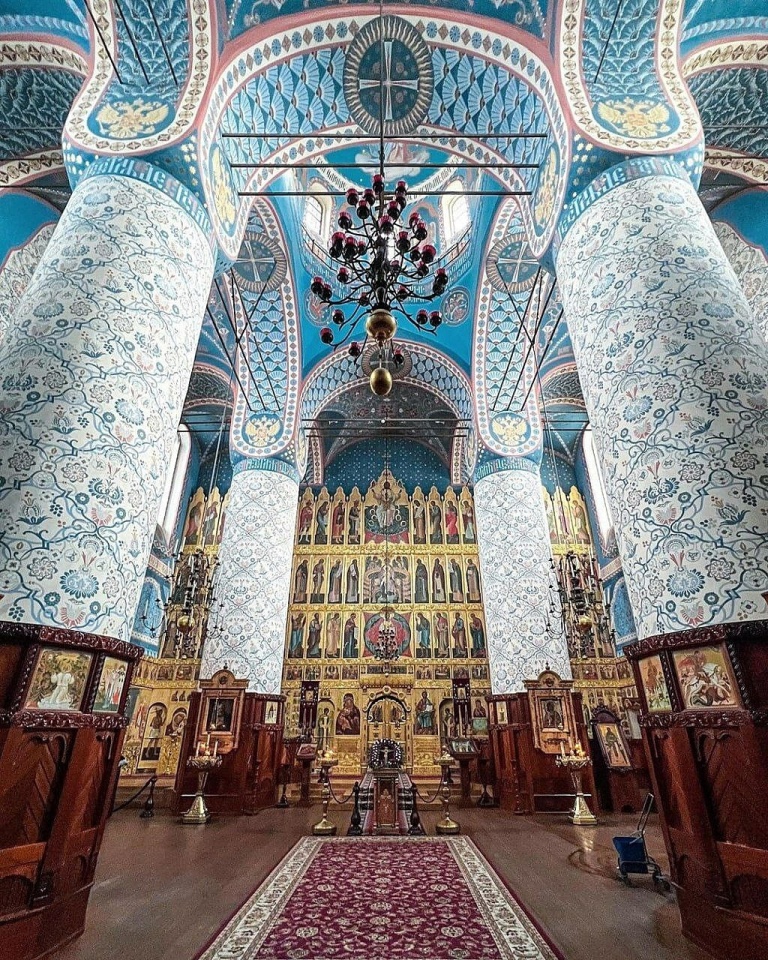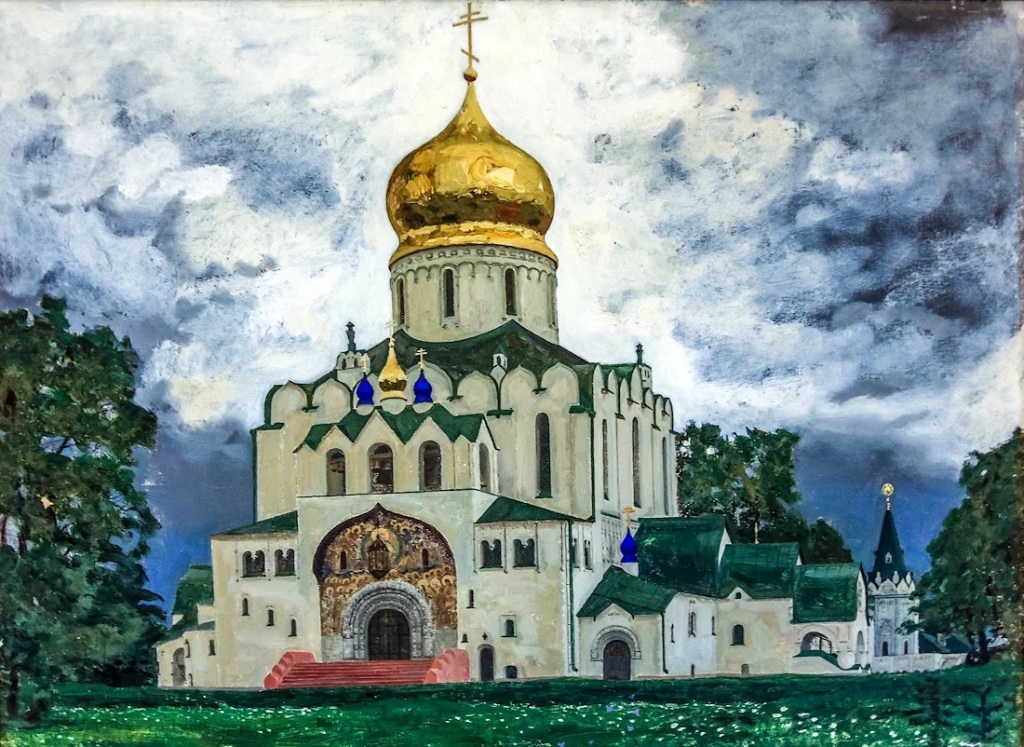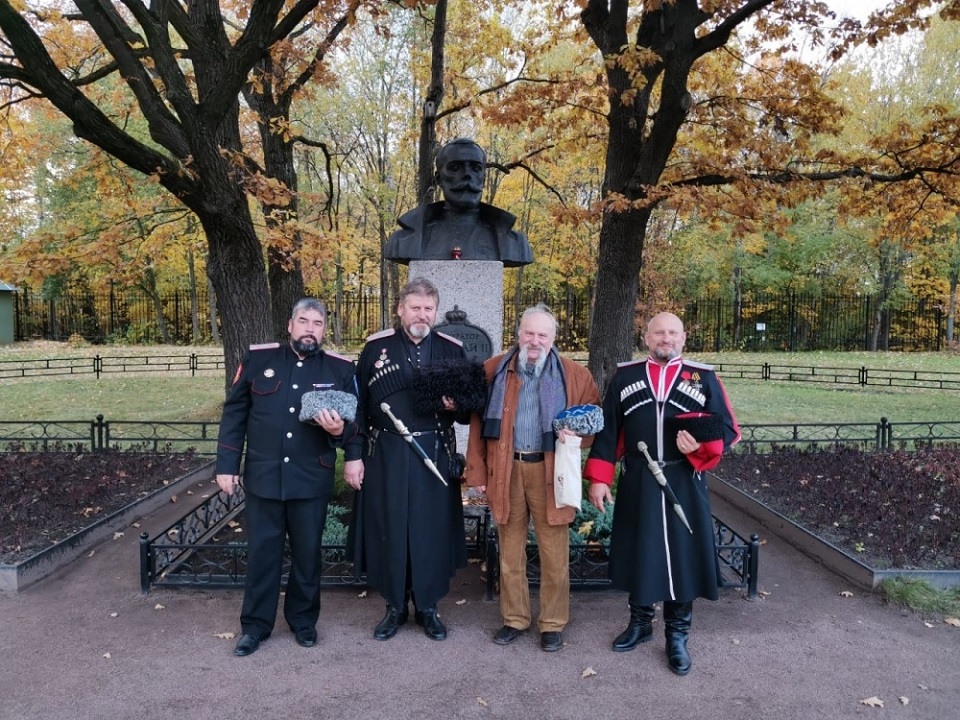The restoration of Nicholas II’s favourite church at Tsarskoye Selo
PHOTO: aerial view of the beautifully restored Feodorovsky Sovereign Cathedral at Tsarskoye Selo – the restoration took 20 years to complete. The buildings of the Feodorovsky Gorodok can be seen to the right of the cathedral’s cupola.
One of the greatest restoration projects carried out during the post-Soviet years has got to be that of the Feodorovsky Sovereign Cathedral at Tsarskoye Selo. The recreation of the Cathedral’s façade and interiors of both the Upper and Lower Churches, are nothing short of a miracle.
Situated a short walk from the Alexander Palace, I recall visiting the Feodorovsky Sovereign Cathedral for the first time in the early 1990s. I was shocked by the appalling state of neglect and disrepair this once beautiful house of worship had endured during the Soviet years. I returned to Tsarskoye Selo many times since, and have been witness to its slow, but magnificent restoration. Glory to God, for all things!
PHOTO: Watercolour of the Feodorovsky Sovereign Cathedral (1914). Artist: Gavriil Nikitich Gorelov (1880-1966)
Nicholas II’s favourite church
When Emperor Nicholas II and Empress Alexandra took up residence in the Alexander Palace in 1895[1], they were surprised that unlike other Imperial palaces, it did not contain a chapel. Therefore, in 1897, they had the Crimson Drawing Room converted into the home church of St. Alexander Nevsky. But this temporary church was clearly not enough, so the Emperor issued a decree for the construction of a new church in the vicinity of the palace.
Between 1908-1912, the Feodorovsky Sovereign Cathedral was built in the old Russian style – much favoured by the Tsar. It’s construction was financed by Nicholas II, who contributed 150,000 gold rubles from his own personal funds. The foundation of the Cathedral was laid on 2nd September (O.S. 20th August) 1909 in the presence of the Imperial family, each member beginning with the Tsar himself, placing a brick in the building’s foundation.
The Feodorovsky Sovereign Cathedral served as the regimental church of both His Imperial Majesty’s Own Infantry Regiment and His Imperial Majesty’s Own Convoy. In addition, the cathedral served as the house church for the Imperial family, while they were in residence in the Alexander Palace.
Externally, the cathedral was simple, austere and majestic, with bright reflections of mosaics on the snow-white walls, crowned with a gilded cupola. The interior was striking in its height and magnificent decoration in the style of ancient Russian church architecture.
The Cathedral consisted of two churches – the Upper Church, with a capacity of up to 1000 people, with the main altar in the name of the Fedorovskaya Icon of the Mother of God, the patron icon of the Romanov family. The Upper Church included a side chapel in the name of St. Alexis, Metropolitan of Moscow (the completion and consecration of which by 1917 was never realized); and the Lower Church [aka the Cave Church] in the name of St. Seraphim of Sarov.
PHOTO: Early 20th century Russian postcard depicting Emperor Nicholas II entering the Feodorovsky Sovereign Cathedral via the Tsar’s Porch.
PHOTO: the restored Tsar’s Porch is located at the southeastern corner of the cathedral. It was through this entrance, that Emperor Nicholas II and his family, accessed the Cave Church, consecrated in memory of St. Seraphim of Sarov.
The solemn consecration of the Cathedral took place on 2nd September (O.S. 20th August) 1912 in the presence of the Imperial Family. The ceremony was performed by the protopresbyter of the military and naval clergy Georgy Shavelsky (1871-1951), who from 15th (O.S. 2nd) June 1913, served as honorary rector of the Cathedral.
A solemn Divine Liturgy was performed by His Grace Theophan, Bishop of Yamburg (1872-1940), attended by the Emperor and members of his family.
While the Imperial Family were in residence in the Alexander Palace, the Emperor and his family visited the Feodorovsky Sovereign Cathedral on holidays and Sundays. They entered the Cathedral via the Tsar’s Porch, which was located at the southeastern corner of the cathedral.
Empress Alexandra Feodorovna often came to pray in the Cave Church, of which she was particularly fond. A special room was arranged for her, which allowed her to retire in prayer privately. The chapel, a small room less than a meter wide, was installed to the right of the altar. It contained a mosaic icon of St. Seraphim of Sarov.
When in residence, Nicholas II did not miss a single Sunday and holiday service in the Feodorovsky Sovereign’s Cathedral. “The service was solemn and remarkably beautiful in our lovely church,” he wrote in his diary. Many laity wanted to pray with the sovereign, however, they were allowed only with tickets, which could be obtained from the palace commandant or the churchwarden.
PHOTO: the Feodorovsky Sovereign Cathedral, as it looked in the 1970s
The Soviet years
Shortly after the Tsar’s abdication in March 1917, the Feodorovsky Sovereign Cathedral was turned into an ordinary parish church. After the Bolsheviks nationalized churches and monasteries, they wasted little time in looting and pillaging the Cathedral. Between 1911 to 1934, members of the Cathedral’s clergy – including six abbots – were arrested and sent to concentration camps, never to be seen again.
In December 1933, the Cathedral was closed by the local Soviet, who argued that the town had too many churches – a total of five. The Cathedral’s property – including the icons – were transferred to the Russian Museum Fund, and later distributed among several museums in Leningrad. To this day, they remain in the collections of the State Russian Museum, the Kazan Cathedral, in the Catherine Palace, Pavlovsk Palace and elsewhere. Much, however, was lost, sold abroad for foreign currency or intentionally destroyed by the Soviets.
If that wasnt’ enough, the Upper Church was adapted for a cinema hall, the screen was placed in the altar space. The Lower Cave Church was turned into a warehouse and an archive of film and photo documents for the “Lenfilm” studios.
During the Nazi occupation of Pushkin (1941-44), the Feodorovsky Sovereign Cathedral was badly damaged. Given that the Cathedral was the tallest point in the town, it became an easy target for Nazi bombers. The walls of the northern façade and the right wing of the western side were partly destroyed. The vaults were also damaged, and the main dome was shattered by a shell.
During the post-war years, the Cathedral was left in a terrible state of ruin, until the 1980s.
After the fall of the Soviet Union in 1991 the Feodorovsky Sovereign Cathedral was returned to the Russian Orthodox Church. Extensive reconstruction and restoration work carried out over a 20 year period has restored it to its historic original.
Post-Soviet restoration
In the spring of 1991, the Cathedral was transferred to the Russian Orthodox Church. In the same year, the Feodorovskaya Icon of the Mother of God was found buried in one of the parks at Tsarskoye Selo. It was returned to the Cathedral and has since become one of its most revered shrines. On 1st March 1992, the first Divine Liturgy was held in the Lower Church, and on 29th August 1996, in the Upper Church.
The restoration of both the façade and interiors of the Cathedral lasted 20 years. The dedication and painstaking efforts to restore Nicholas II’s favourite church by an army of artists, restorers and historians is much to be admired, as the photos below will attest:
PHOTO: partial view of the restored iconostasis in the Upper Church
PHOTO: view of the restored main dome of the Upper Church
PHOTO: view of the restored iconostasis in the Upper Church
PHOTO: partial view of the restored iconostasis in the Upper Church
PHOTO: Icon of the Holy Royal Martyrs Nicholas II and Alexandra Feodorovna in the Upper Church
PHOTO: views of the restored Lower Church, where the Imperial Family came to pray
PHOTO: winter view of the Feodorovsky Sovereign Cathedral. Note the gilded double-headed eagles perched on the pillars of the main gate
On a final note . . .
There are some Orthodox Christians who have suggested that once the Russian Orthodox Church recognize the Ekaterinburg Remains as those of the Imperial Family, that the Feodorovsky Sovereign Cathedral at Tsarskoye Selo should be considered as the final resting place for the Imperial Family and their four faithful retainers that perished with them in Ekaterinburg. According to one source, such a decision would thus fulfil the wish of Nicholas II and Alexandra Feodorovna.
It seems only fitting that they should find eternal rest in a place which they held so near and dear to their hearts, one where they came to pray and find spiritual nourishment. Just a thought . . .
NOTES:
[1] Shortly after the events of Bloody Sunday in February 1905, Nicholas II made the Alexander Palace his permanent residence.
© Paul Gilbert. 14 July 2023











































































You must be logged in to post a comment.